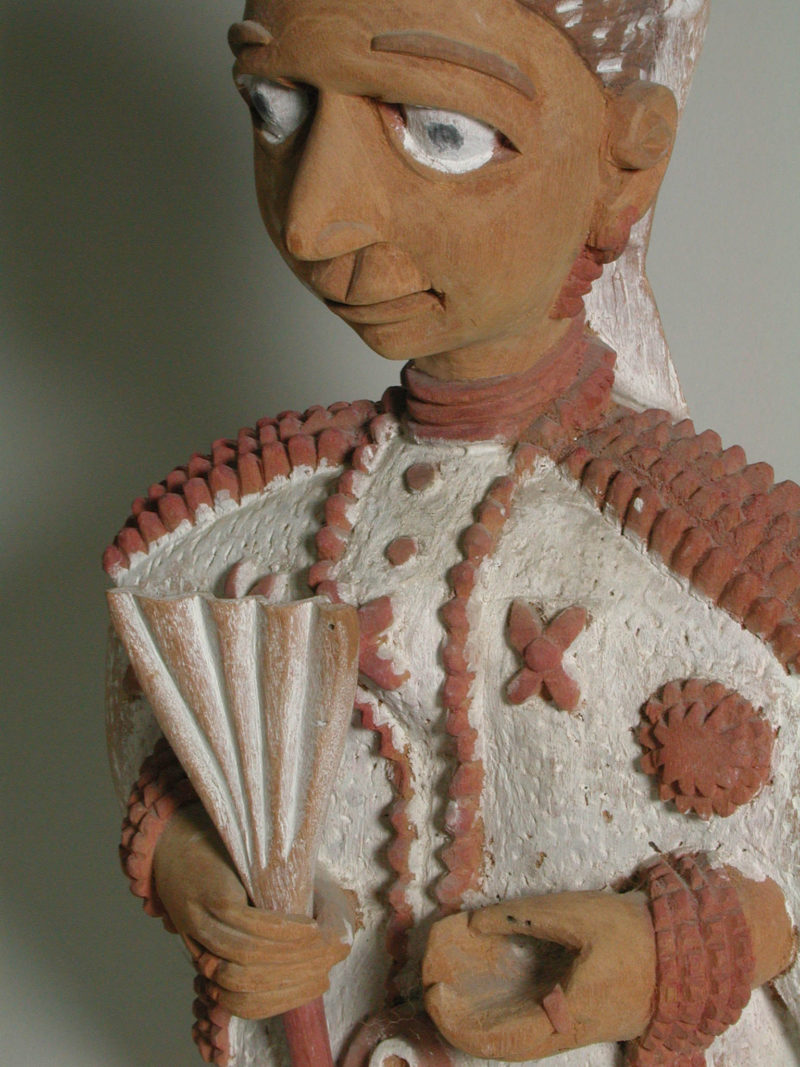Early Tourist Arts of the Yoruba
Former Museum Director William Bascom first saw a version of the District Officer sculpture during his first fieldwork in Nigeria in 1937–38. This complex set shows the Officer in the front, four paddlers, and the steerer at the rear. In addition to the boat and six figures, there are many separate pieces: an umbrella (a symbol of status and authority in West Africa) and its handle, four paddles, pole, flag, pipe, and helmet.
Wherever they may travel, tourists invariably search for small, portable objects that they can bring home as souvenirs. One popular variety illustrates the visitor rather than the native. Africa has had an especially long history of representing foreigners, going back at least to the bronze depictions of visiting Portuguese in the 16th century. Given the Phoebe A. Hearst Museum of Anthropology’s great Yoruba collection, amassed mostly by former director William R. Bascom, it is not surprising that the Museum would have a substantial representation of early Yoruba examples. Here, we focus on the work of two great innovative carvers of the early to mid-20th century.

Sculpture of Queen Victoria. Collected by William R. Bascom, Lagos, Nigeria; possibly 1943. Cat. No. 5-16238a,b.
Through his personal friendship with the artist, William Bascom was able to acquire twelve figures carved by Thomas Ona Odulate (ca. 1900–52). Born and raised in Ijebu Ode, Nigeria, Ona later moved to Lagos, where he produced great quantities of novel woodcarvings depicting both colonials and Yoruba. Among the former were administrators, soldiers, lawyers, doctors, butchers, missionaries, polo players, married couples, even Queen Victoria. The Yoruba included both traditional roles and new, colonial occupations: mothers and children, masked dancers, kings and messengers, hunters, policemen, and postmen. Almost all were sold to the British; while some were commissioned, most were made in advance and then marketed.
While Ona’s figures are pioneering in subject matter, they are traditional in style. They follow usual Yoruba proportions, with a large head equal in size to the torso and legs. Ona used the traditional Yoruba carving tools of adze and knife. He painted the figures in red and black ink, white shoe polish, leaving the natural tan of the wood. However, unlike traditional Yoruba sculpture, which is usually carved out of single piece of wood, many of Ona’s carvings have separate parts, such as hats, guns, books, mallets, or umbrellas. And like most tourist arts, Ona’s sculpture often exists in multiple, similar versions. While they seem to be satirical or caricatures, and have been so identified, Ona told Bascom that his works simply showed how he viewed the world around him.

Collected by William R. Bascom, Nigeria; before 1953.
A related, and more or less contemporary, form are the so-called “thorn carvings,” of which the Museum has about seventy-five. This genre was invented by Justus D. Akeredolu (1915–83). In the mid-1930s, while working as a crafts teacher in government schools in Nigeria, he started experimenting when carving the handles of name-stamps made from the large thorns of the silk-cotton tree. After studying museum work in Britain on a scholarship, Akeredolu returned to Nigeria in the 1950s, where he worked as an assistant for the Antiquities Service, mainly restoring sculptures of wood, bronze, and stone. Even after losing an eye in 1963, he continued to carve.
Akeredolu taught this art form to his apprentices and to other craft schools. His works are especially fine: they tend to be made of a single block of light wood, very detailed, and are usually signed. Later carvers often made the figures from separate pieces, combining light and dark woods, and were slightly larger and somewhat cruder. Because they were made of separate pieces, they could be more easily mass-produced. But just because of their larger size, they could be more elaborate, often containing two or more figures set on a wooden base. These miniatures illustrate a wide range of everyday Yoruba customs: hoeing, herding cattle, climbing palms, pounding food, making pots, smithing, dressing hair, playing games, drumming, dancing, and studying the Koran.
These inventive figurines are compelling examples of Yoruba artistry, and the Museum is fortunate to have such a large collection made by the creators of this genre.
